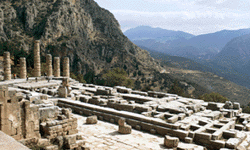
View of the Sanctuary of Pythian
Apollo at Delphi (look
at large sized version)
Photo courtesy of D.
White
|
Greece is the southeasternmost region on the European continent. It is edged by a series of mountains, surrounded on all sides except the north by water, and has many large and small islands. The Ionian and Aegean seas and the many deep bays and natural harbours along the coastlines allowed the Greeks to trade by sea and to develop a culture which owed part to many other parts of the world. The Greek world eventually spread far beyond Greece itself, having many settlements around the Mediterranean and Black seas and, during the Hellenistic period, reaching as far east as India. Look at large version of map |
|
The mountains, which served as natural
barriers and boundaries, were important to the character of
Greece. From early times the Greeks lived in independent
communities isolated from one another by the landscape.
Later these communities were organized into poleis
or city-states. The mountains prevented large-scale farming
and forced the Greeks to look beyond their borders to new
lands which were better for farming. Natural resources of
gold and silver were available in the mountains of Thrace in
northern Greece and on the island of Siphnos, while silver
was mined from Laurion in Attica. Supplies of iron ores were
also available on the mainland and in the Aegean
islands. The Mediterranean Sea affects Greece´s climate, cooling the air in summer and providing warmth in the winter months. Summers are generally hot and dry. Winters are mild and rainy in coastal regions and cold and snowy in mountainous areas. |
The Ancient Greek World Index
